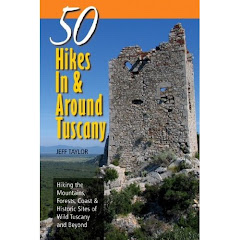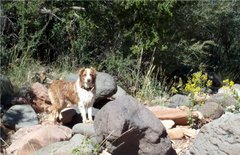Distance: 10.1 miles (16.2 km)
Elevation: 3,990 - 5,126 feet (1,215 - 1,563 m)
Difficulty: Strenuous
Time of Year: October to May
 |
| View of Caldera Rim of House Mountain Shield Volcano |
Located about halfway between Sedona and Cottonwood, is the House Mountain Shield Volcano. It erupted approximately 15 million years ago right along the edge of the Mogollon Rim (the geophysical boundary of the Colorado Plateau). Its lava flows actually preserved the edges of the rim, allowing geologists to estimate the rate of recession of the rim. Today, the Mogollon Rim is some 8-10 miles away, on the other side of Sedona, and thus it has been determined that it is eroding back at a rate of 1 foot every 600 years. That may sound slow, but actually that is amazingly rapidly in geologic time, especially since the rim is some 2,000 feet high!
From the summit of House Mountain, there are spectacular views of the Sedona Red Rock Country, Mogollon Rim, San Francisco Peaks, Verde Valley, and the Verde Rim/Black Hills. To reach the trailhead, drive south from Sedona to the Village of Oak Creek. Follow Verde Valley School Road to the west until the pavement ends. Continue on the dirt road a short ways until you see the first major left. This is FS9892 and there will be a sign that says Turkey Creek Trail. Follow this very rough dirt road about 1/2 mile to the parking area.
 |
| The lush green of grass and cottonwoods at Turkey Creek Tank |
The trail starts out crossing the typical red rocks of the Schnebly Hill Formation. This limey sand and mudstone formed as rivers from the ancestral Rockies and Appalachians deposited their silt on the flat floodplains and estuaries of the ancient sea. The trail is pretty easy until reaching a grassy meadow and then approach the cottonwoods of Turkey Creek Tank. This tank is filled in and dried up, but cottonwoods and willows indicate the soils are moist where a spring once flowed. Turkey Creek itself is nothing more than a rocky dry wash.
 |
| Climbing up to the rim of the caldera |
From the tank, the trail goes over several rolling hills and then heads up into an amphitheater. At the back of the amphitheater, the trail begins to climb steeply up the cliff face toward the dark gray rim above. The dark gray rocks you see above are the volcanic lavas from the volcano.
 |
| View across the caldera to the summit of House Mountain |
After several switchbacks, you end up at the edge of the rim of the caldera at an elevation of 4,630 feet, nearly 650 feet above where you started. From the outer edge of the rim, you see panoramic views of Sedona and the Mogollon Rim. Inside the rim, you can look down into the juniper-covered caldera and across to the rocky summit of House Mountain. At this stage, you have come 3.2 miles. Most people end their hike here by doing a quick scramble up to the rocky outcrops to the left for lunch and then return back the way they came.
 |
| Climbing up through the cactus off trail |
But, for those more adventurous souls, follow the ATV track that starts at the rim's edge straight ahead as it first follows the eastern edge of the caldera and then drops down into it. You will see lots of signs of cattle activity in this area. The ATV track will drop into the caldera and then will climb up on the other side, following a dry creek bed. As it reaches the opposite rim of the caldera, you will pass a small cattle pond and then emerge onto a saddle with your first views out toward the Verde Valley. Here, there is a Forest Service road marker indicating a "road" heading off to the left (east), as well as, the ATV track that heads down the other side of the mountain.
 |
| On the rim of the caldera near the summit |
This is where the hike gets really tricky. To reach the summit of House Mountain, you will need to go off track, going straight up the cactus-covered slopes to your right. The rocks are very loose and you will need to weave your way between the large and densely packed prickly-pears as you scale the hill. But, once you reach the top of the hill, you have 360 degree panoramic views in all directions.
 |
| The Mogollon Rim with the San Francisco Peaks beyond |
The first hill is a false summit, as when you reach its rounded top you will see a rocky formation just a bit further. That is the true summit of House Mountain, and it is so named because it superficially looks like a house on top of the mountain from Cottonwood.
 |
| View down into the Verde Valley with Woodchute Mountain beyond |
From the summit area, you can look across Sedona to the Mogollon Rim, with the snow-capped San Francisco Peaks rising above it. To the northwest, you can see Bill Williams Mountain, which is the westernmost (and oldest) of the volcanoes in the San Francisco Volcanic Field. To the east, you can see the broad volcanic plains near Mormon Lake, as well as, the canyons that deeply cut into the rim, such as Wet Beaver Creek. To the southeast, you can see several cinder cones rising above the Mogollon Rim, with 8,000 foot Baker Butter the largest of them.
 |
| The summit rocks |
To the south, you can look down into the village of Cornville directly below, Camp Verde to the southeast, Cottonwood in the distance to the southwest, and Mingus Mountain and the Verde Rim rising high above the valley.
 |
| View of the Mogollon Rim with Baker Butte Cinder Cone (right) Wet Beaver Canyon cuts deep into the rim below |
After taking in the view, be prepared for a very slick descent down, as the volcanic rocks are like walking on marbles. You will return exactly the way you came. Rumor has it that there is another way back down going on the otherside of the caldera, but I did not see it.
 |
| Hiking back down into the red rock |






























































